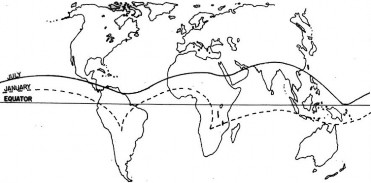2.4. Weather Conditions in the Summer Reason
♤ Surface Pressure and Winds - As the summer sets in and the sun shifts northwards, the wind circulation over the subcontinent undergoes a complete reversal at both, the lower as well as the upper levels. By the middle of July, the low pressure belt nearer the surface, termed as Inter Tropical Convergence Zone (ITCZ), shifts northwards, roughly parallel to the Himalayas between 20° N and 25° N (Figure 3). It extends from Punjab to the Chota Nagpur plateau. By this time, the westerly jet stream withdraws from the Indian region. There is a cause and effect relationship between the northward shift of the ITCZ and the withdrawal of the westerly jet stream from over the North Indian Plain.
Being an area of low pressure, the ITCZ attracts winds from all around. The maritime tropical airmass (mT) from the southern hemisphere, after crossing the equator, rushes to the low pressure area in the general southwesterly direction (Figure 4). These winds cross the Equator between 40°E and 60°E longitudes. Blowing over the ocean for a long distance, they pick up a large amount of moisture. It is this moist air current which is popularly known as the southwest monsoon.

4 For more details about extra-tropical cyclones (known as western disturbances in Indian subcontinent),
See document “INSOLATION, EARTH’S HEAT BALANCE, DIFFERENT ATMOSPHERIC…”

